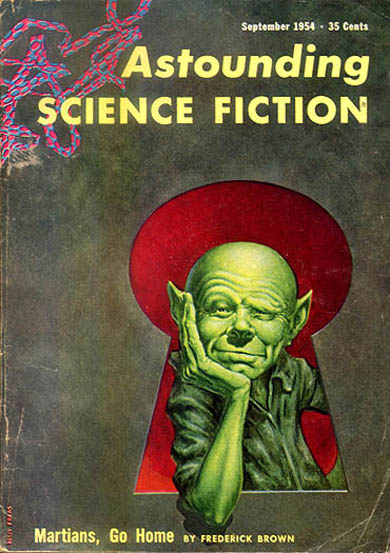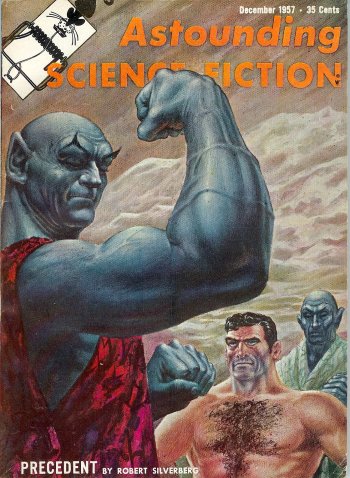PULP COVER FRIDAY PRESENTS: Astouding Aliens Down Through The Ages
This time around I thought I’d do a shout-out to another favorite zine of mine, the longest continually-published sf magazine (Jan. 1930 to this very day), ASTOUNDING STORIES OF SUPER-SCIENCE, or, as it’s known (less pulpishly) today, ANALOG. I must say that I miss the original title, even in its less-bombastic form (ASTOUNDING SCIENCE FICTION) but John W. Campbell, ASTOUNDING’s guiding light for lo those many years was a frustrated scientist (though he believed in such crack-pottery as Dianetics, the Dean Drive, and perpetual motion machines) and I have the feeling that he was more than a little embarrassed by the zine’s pulpish roots. Hence the name change to the boring, dryly scientific, and mostly meaningless ANALOG. Still, in my youth it was my favorite sf mag. Not the first I ever bought, but the first that I subscribed to, and still do to this day.
To narrow it down my choices a bit, I decided to focus on their depictions of aliens. Which still leaves us with a lot of territory, so we’d better get started.
Cover aliens were common in the 1930’s, and were mostly menacing, wildly imaginative, and not at all human looking, as in this cover, which happens to be the magazine’s first issue (1-30)
This one gives us two aliens to ponder (8-30)
Somewhat more human, no less menacing (11-30).
Intelligent or animal? I guess we’d have to read the story to find out for sure, but he does seem to be wearing glasses (5-31).
Here’s something different, a girl OUTSIDE the glass, who seems to be directing our hero’s fire, or maybe she’s commenting on the alien’s wife-beater tees (10-31).
By the 1940’s we get fewer aliens and more tech stuff (like rockets) on the covers. For the most part, the aliens depicted are more human-like and less menacing, like this attractice couple (7-40).
There is, of course, always an exception to every generalization (10-42)
The decade of the 1950’s continues the “humanization” of the aliens.
As I said above. Note: The “iceworld” is clearly the Earth. (I’ve read this one by the master of hard sf, Hal Clement. Not as good as his classic MISSION OF GRAVITY, but interesting.)
Aliens even become the subject of humor, as shown by this masterful portrait by Kelly Freas of the disrepected Martians of Fred Brown’s classic “Martians Go Home.”
Some, however, are still pugilistically inclined (12-57). Story by Robert Silverberg, who was the most awesomely prolific sf magazine writer of the 1950’s.
More alien as butt of humor (4-59). “Winston Sanders” is the not-quite-as-awesomely-prolific-as-Robert-Silverberg Poul Anderson, but (off the top of my head) the third most prolific sf magazine writer of the 1950’s. He managed to sustain a higher level of quality than most.
Now we hit the 1960s and the name change to ANALOG. Surely you recognize the awesome sandworm from the novel known more widely under its book name, DUNE (3-65)
Aliens not as enemies to man, but equal partners. Another Poul Anderson story.
This cover doesn’t show aliens of an unearthly sort, but alien intelligences nonetheless. “P.I.G.” stands for Porcine Interstellar Guard, and the tiny hog under the man’s arm is the delightful Jasmine, a Chinese Pink (if I remember the breed correctly) and a porcine genius. Terrific story.
The story that turned dragons into their own little literary industry.
This is about when I started reading the magazines. At the time, it (and many of his other contributions to Analog throughout the 1970s) made Gordon Dickson my favortie sf writer. He no longer ranks quite so high in my estimation, but he did write some fine stuff (novels and shorts both) in this time period. WOLFLING remains a personal favorite. The aliens in it are not only competitors with humanity, but the protagonist falls in love with one despite her not entirely human appearance.










There are no comments